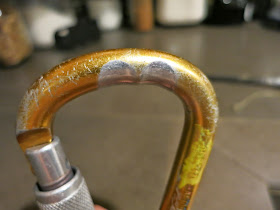One of the most confusing elements for a new climber is how the climbing
class and grade systems work in the United States. Many individuals go
to the rock gym and feel like they understand what a 5.7 feels like,
but seldom understand where that grade came from. Many wonder why it's
not simply a 2 or a 3 instead of a 5.7.
In North America we use the Yosemite Decimal System to define the class of a climb. This system provides a class number and then a specific grade. Following is a breakdown of the classes:
Class 1 - Hiking on a maintained trail.
Class 2 - Easy scrambling. Some may occasionally need their hands.Class 3 - Moderate scrambling. Hands may be employed more often.
Class 4 - Easy climbing. Hands are used all the time. Many will climb at this level without a rope.
Class 5 - Where real rock climbing begins. Technical equipment is employed at this level.
At Class 5 we add a decimal and a number to the system. Periodically a plus or a minus will be used in conjunction with the class identification (i.e. 5.6+ or 5.8-). Once the system hits 5.10, a letter grade is added. There are four letter grades before the number grade changes. (i.e. 5.10a, 5.10b, 5.10c, 5.10d, 5.11a, 511b...). Following is a breakdown of this system;
5.0-5.6 - Beginner level climber
5.7-5.9 - Intermediate level climber
5.10a-5.11c - Advanced level climber
5.11d-5.13d - Professional climber
5.14a-5.15b - World class climber
Currently 5.15b is the hardest grade climbed in the world. However, the system is open-ended and one day somebody will climb something that is 5.15c.
Though climbers strive for consistency in grades, this breakdown is often quite subjective. In other words, a 5.10a in Red Rock Canyon might be the equivalent of a 5.8 in Joshua Tree National Park. It's important for climbers to get a feel for how the grades work in every new area they visit before pushing themselves too hard.
Many long rock and alpine climbs also employ a Roman Numeral commitment grade. This grade gives the "average climber" an overview of how long the route will take, how many pitches are technical, how difficult the routefinding on the route might be, and in some cases it will also take into account the remoteness of the climb. The commitment grades are as follows:
Grade I - A very short route requiring one to two hours.
Grade II - A route that takes two to four hours.
Grade III - A route that takes the better part of a day. For slower parties a Grade III will be an all day endeavor.
Grade IV - A route that takes all day. Generally a day that requires in excess of 12 hours. The technical difficulties are more pronounced.
Grade V - Generally takes more that a day. There are clear technical difficulties to be overcome.
Grade VI - A multi-day climb that requires solid technical skills and often requires both aid and free climbing techniques.
As with the Yosemite Decimal System, the commitment grade system is not without problems. It is incredibly subjective. The Nose on El Capitan in Yosemite is a Grade VI. When it was first climbed in 1958, it took 45 days. The speed record is currently under three hours and many parties complete the route in a day. So the question must then be asked, what is an "average" climber? How should these grades be set? Most guidebook authors will look for some kind of consensus. The real average party on the Nose still takes about four days. As such, the Grade VI will remain for the time being.
--Jason D. Martin
In North America we use the Yosemite Decimal System to define the class of a climb. This system provides a class number and then a specific grade. Following is a breakdown of the classes:
Class 1 - Hiking on a maintained trail.
Class 2 - Easy scrambling. Some may occasionally need their hands.Class 3 - Moderate scrambling. Hands may be employed more often.
Class 4 - Easy climbing. Hands are used all the time. Many will climb at this level without a rope.
Class 5 - Where real rock climbing begins. Technical equipment is employed at this level.
At Class 5 we add a decimal and a number to the system. Periodically a plus or a minus will be used in conjunction with the class identification (i.e. 5.6+ or 5.8-). Once the system hits 5.10, a letter grade is added. There are four letter grades before the number grade changes. (i.e. 5.10a, 5.10b, 5.10c, 5.10d, 5.11a, 511b...). Following is a breakdown of this system;
5.0-5.6 - Beginner level climber
5.7-5.9 - Intermediate level climber
5.10a-5.11c - Advanced level climber
5.11d-5.13d - Professional climber
5.14a-5.15b - World class climber
Currently 5.15b is the hardest grade climbed in the world. However, the system is open-ended and one day somebody will climb something that is 5.15c.
Though climbers strive for consistency in grades, this breakdown is often quite subjective. In other words, a 5.10a in Red Rock Canyon might be the equivalent of a 5.8 in Joshua Tree National Park. It's important for climbers to get a feel for how the grades work in every new area they visit before pushing themselves too hard.
Many long rock and alpine climbs also employ a Roman Numeral commitment grade. This grade gives the "average climber" an overview of how long the route will take, how many pitches are technical, how difficult the routefinding on the route might be, and in some cases it will also take into account the remoteness of the climb. The commitment grades are as follows:
Grade I - A very short route requiring one to two hours.
Grade II - A route that takes two to four hours.
Grade III - A route that takes the better part of a day. For slower parties a Grade III will be an all day endeavor.
Grade IV - A route that takes all day. Generally a day that requires in excess of 12 hours. The technical difficulties are more pronounced.
Grade V - Generally takes more that a day. There are clear technical difficulties to be overcome.
Grade VI - A multi-day climb that requires solid technical skills and often requires both aid and free climbing techniques.
As with the Yosemite Decimal System, the commitment grade system is not without problems. It is incredibly subjective. The Nose on El Capitan in Yosemite is a Grade VI. When it was first climbed in 1958, it took 45 days. The speed record is currently under three hours and many parties complete the route in a day. So the question must then be asked, what is an "average" climber? How should these grades be set? Most guidebook authors will look for some kind of consensus. The real average party on the Nose still takes about four days. As such, the Grade VI will remain for the time being.
--Jason D. Martin



















